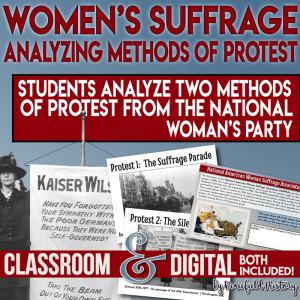Description
This unit plan contains standards-aligned and engaging student-centered lessons relating to World War I. Students will learn all about how the war impacted the United States and the homefront. They will also learn the basics about the wartime experience overseas. You can view more in the preview here – World War One Full Unit Preview.
Students will complete a teacher-led presentation with options to analyze wartime propaganda, determine whether wartime restrictions were essential or excessive, investigate trench warfare, and compare Europe before and after World War I. Students also investigate the homefront by comparing two types of protests relating to the women’s rights movement to see the ways women were treated for speaking out for their rights – regardless of their method of protest, determining whether wartime service actually improved the lives of Black soldiers, and assessing the impact of restrictive wartime laws. They will also closely read the words of the Fourteen Points.
As an assessment, students also complete a structured inquiry that compares Wilson’s treatment of groups of people on the homefront to the ideals he outlined in the Fourteen Points.
Within each product:
- Classroom handouts for each lesson and the Unit assessment (PDF, PowerPoint, and Google Slides link)
- A Google Slides version of the lesson can be assigned in Google Classroom (Google Slides link).
© Copyright 2024 Peacefield History. All rights reserved.
Permission is granted to copy pages specifically designed for student or teacher use by the original purchaser or licensee. This is intended to be used by one teacher unless additional licenses have been purchased. The reproduction of any other part of this product is strictly prohibited. Copying any part of this product and placing it on the Internet in any form besides Google Classroom is strictly forbidden. Doing so makes it possible for an Internet search to make the document available on the Internet, free of charge, and is a violation of the Digital Millennium Copyright Act (DMCA).









Reviews
There are no reviews yet.